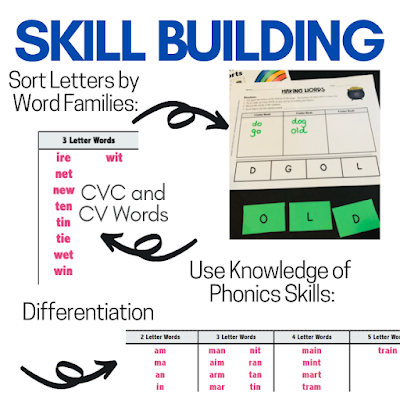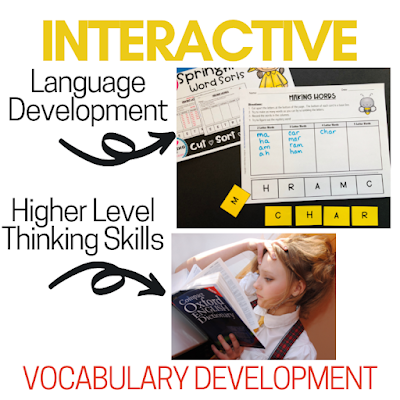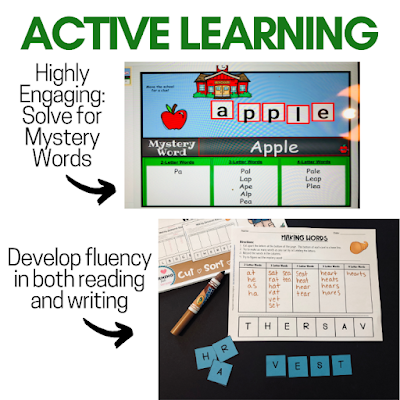Are you looking for an engaging way to reinforce phonics skills in your classroom? Discover how Mystery Word Sorts can transform your students' learning experience!
Inspired by Tim Rasinski’s work with “word ladders” and “making and writing words”, Mystery Word Sorts are a word play activity in which students use a limited amount of letters to make both short and long words--eventually trying to discover the thematic “mystery word.”
Directions for Use
Choose a word sort from the packet--Back to School Sort.
Photocopy for each student.
Have students cut out letters on the bottom.
Students sort letters and record words in columns, based on the length of each word.
Students record Mystery Word on the top line, when discovered. This is the word, which contains ALL of the letters in the set.
Optional: Have students use the free CVC Sorting graphic organizer or other Phonics Sheets, to isolate specific phonological patterns.
 |
| Use dry erase board or table to record Vowel Teams! |
Specific Instructions for Students
Students apply their knowledge of common phonological word patterns, by first identifying the vowels and consonants in the scrambled set of letters.
Remind students that the words they make must contain only these letters. Each letter may only be used once, unless it appears more than once in the letter set.
Students then begin to use known spelling structures (CVC, CVCe, CVVC words) to make words. (Each word sort includes a free CVC word graphic organizer.) 👇
 |
| Highlight vowels to "anchor" words while sorting! |
Explain how the scrambled letters will form a special Mystery Word. This Mystery Word contains all of the letters in the set. These are thematic words. For example, the school word sorts are all based on words related to a typical school experience; the October word sorts are related to autumn or Halloween.
Themes include both holidays and topics of the months! You can find the entire Seasonal Word Sort Bundle here--this is a GROWING BUNDLE!
When a student discovers the Mystery Word, he/she should record it on the word sort sheet. It can be exciting to announce this discovery, so students may need a reminder to keep it a secret so others can discover the word, too!
There is a picture clue on the top right corner of each sort. If the picture clue is too obvious, this can be covered up during photocopying. (Note: on the digital version, there is an image covering the picture clue, which can be moved to reveal the clue!)
 |
| Unscramble ALL of the letters to solve for the Mystery Word! |
Note: Mystery Words are typically between 5-8 letters long and contain 1-2 vowels!
How long should it take to sort?
We typically spend about 10-15 minutes each day doing a Mystery Word Sort. At the beginning of the year, this may take a bit longer as more modeling is needed.
You can scaffold this activity in many ways. Students may be required to find a specific number of words (ex. find 5-10 words.) You may have students work on one column first (ex. find as many 3-letter words as you can.) You can also use these sorts during small group instruction, such as guided reading or guided writing groups.
This can also be used in combination with dictionary skill-work. Third graders, for example, typically begin using dictionaries in late fall. At this time, they may keep a dictionary on their desk, to check words as they sort. This is also a great way to blend vocabulary acquisition into the sorting activity!
Once students have gained confidence, this is an activity they will be able to do independently. There is a digital version of this activity, as well. This can be used to transfer students into a more independent version of the activity, where they learn how to sort the letters through Google Apps. This blends technology skills such as dragging, selecting, text boxes and typing! This can also be used in remote instruction and distance learning!
 |
| Cut and sort letters to form as many words as possible. |
Why is this important?
The more students are exposed to this type of word play, the more likely they are to gain growth in word recognition. The more students practice these sorts, the more likely they are to develop fluency with phonics patters in both reading and writing. The sorts are also highly engaging, keeping learning fun and fresh!
Skills Include
phonics pattern usage and development
blends, digraphs
decoding
word parts or known words
vocabulary acquisition
syllable work
semantics
Ways to Differentiate
Guide students in the process of word-creation, by giving verbal clues such as, “Make a 3-letter word, which names an animal.”
Do sorts with students (modeling on overhead or if sitting in a small group
Cover up the picture clue on the top right corner of the sort, to challenge students.
Have students work on various columns, to focus on specific phonics patterns. For example, have students begin with 3-letter words and solely focus on CVC words.
Give students word family clues, “Make words in the -at family.”
Add word-extension activities, such as the use of apostrophes, plurals, compound words, etc...
If you purchase the Growing Bundle, you have access to all of the seasonal sorts! This keeps the sorts fun and fresh!
Helpful tips
Have students highlight the vowels. We call them our anchor vowels, as we use them to guide or word-creation
Students will have varying levels of endurance and some may fatigue out early. You can differentiate by setting goals for various students (find 5 words or 10 words) (find two 2-letter, two 3-letter, and one 4-letter word.
Use a paperclip or single staple, to attach cut-out-letters to the top corner of the page (when students are finished OR if they need more time.)
Challenge students to share these letters with their families, to see if they can find more words!
Use the CVC Word mat (and others) to help students isolate word families. Double Tip: place these in dry erase folders or laminate them for multiple use and less photocopying.
If the small paper letters are too challenging for a student to manipulate, replace them with magnetic letters or allow students to use dry erase board/markers to scramble and make words.
Teaching Tools and Materials
- Magnetic Letters: Useful for modeling the hands-on phonics practice for each sort.
 |
| Use magnetic letters to target vowel patterns and move consonants around. |
- Pocket Charts: Perfect for storing word sorts during group activities.
 |
| Index-sized individualized pocket chart storage for Mystery Word Sorts |
- Highlighters: Helpful for differentiating between consonants and vowels.
 |
| Use highlighters to mark vowels and/or consonants to help "anchor" words during sorts. |
- Dry-erase Boards: Ideal for quick, interactive word-building practice during phonics lessons.
 |
| Small dry erase boards for practicing phonics skills during Mystery Word sorts! |
Related Games and Activities
There are so many ways to make phonics fun! Once students have a solid grasp on how to do the word sorts, these are some fun extension activities they may enjoy participating in:
- Crossword puzzles
- Word Apps: Word Nut
- Word Ladders
- Scrabble
- Bananagrams
- Check out this list by Scholastic for Parents about Digital Word Games for Kids!

Phonics fun with Banangrams!
Check out the other Mystery Word Packages:
January
January Word Sort Bundle: Full package 20 words
Free January Word Sort
Martin Luther King Jr.: Full package 20 words
March
St. Patrick's Day Word Sorts: Full Package 30 Sorts
March
Spring Word Sort Bundle: Full package 30 words
September
Back to School Word Sort Bundle: Full package 20 words
October
October & Halloween Word Sort Bundle: Full package 20 words
Free Halloween Word Sort
November
November & Thanksgiving Word Sort Bundle: Full package 20 words
Thank you for visiting! If you are looking for more HANDS-On and DIGITAL resources, please visit me at my Teachers Pay Teachers Store!
























.png)
.png)








No comments